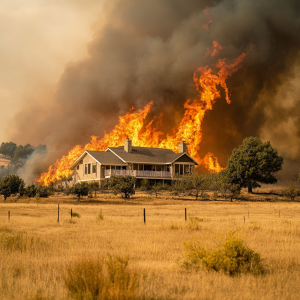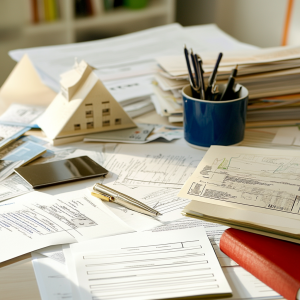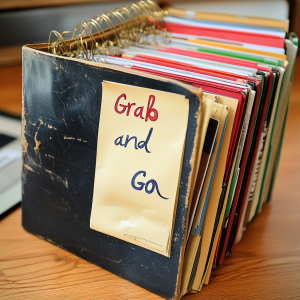
wildfire requires quick evacuation
In the blink of an eye, our lives can be turned upside down. Just recently, a dear friend of mine experienced this firsthand when they were forced to evacuate their home due to rapidly spreading wildfires. In the chaos and panic of those moments, they had precious little time to gather what was important before fleeing to safety. Now, as they pick up the pieces of their life after losing their home, they’re grappling with the realization of all the crucial items they wish they had grabbed in those frantic moments.
This heart-wrenching experience serves as a stark reminder of the importance of being prepared for the unexpected. One of the most valuable tools in any emergency preparedness plan is a “Grab and Go” binder – a carefully curated collection of essential documents and information that can help you navigate the aftermath of a disaster or emergency evacuation.
What is a “Grab and Go” Binder?
A “Grab and Go” binder is exactly what it sounds like: a portable, easily accessible collection of your most important documents and information. It’s designed to be quickly grabbed in case of an emergency evacuation, ensuring that you have all the critical paperwork and details you need to rebuild your life if the worst should happen.
Why is a “Grab and Go” Binder Essential?
In times of crisis, clear thinking often goes out the window. The adrenaline and stress of an emergency can make it difficult to remember and locate all the important documents you might need. A pre-prepared “Grab and Go” binder eliminates this problem, ensuring that you have everything in one place, ready to go at a moment’s notice.
Moreover, in the aftermath of a disaster, having quick access to important documents can significantly streamline the process of dealing with insurance claims, accessing financial resources, and proving your identity and property ownership. Without these documents, you might face significant delays and complications in rebuilding your life.
What Should Your “Grab and Go” Binder Contain?
Based on expert recommendations, your “Grab and Go” binder should include the following categories of documents:

Get a copy of all valuable contracts, deeds, and assets
- Financial Documents
- Personal Documents
- Household Documents
- Legal Documents
- Medical Documents
Let’s break down each of these categories in more detail:
Financial Documents
This section should include copies of your credit and debit cards (front and back), property deeds, car titles, and information about all your bank accounts. Include copies of insurance policies, car registrations, and contact information for anyone who sends you bills. Don’t forget to add copies of any savings bonds, stocks, or investment statements.
Personal Documents
For each family member, include copies of essential identification documents such as birth certificates, driver’s licenses, passports, and Social Security cards. Add recent photos of each family member and pet, as well as important documents like military records, diplomas, transcripts, and resumes. Don’t forget to include a list of emergency contacts. Be sure to include ownership information on your furry family members as well as their shot history.
Household Documents
This section should contain color photos of your house (both exterior and interior), along with photos and appraisals of valuable items. Include a list of firearm serial numbers and receipts for high-value items like furniture, appliances, and electronics. If you’re renting, add a copy of your lease agreement. Otherwise, have a copy of your mortgage.
Legal Documents
Include copies of important legal papers such as wills, trusts, child custody or adoption documents, divorce papers, and any binding contracts. Don’t forget to add contact information for your attorneys.
Medical Documents
This crucial section should contain copies of health insurance cards, a list of blood types for each family member, contact information for all doctors, and medical histories. Include a list of current prescriptions with dosage information and pharmacy contacts. For family members with significant health issues, include copies of relevant medical records and test results.

Grab and Go Binder
How to Organize Your Binder
Use a sturdy three-ring binder and organize your documents with dividers. For added protection, place each document in a plastic page protector. This not only keeps the documents safe from water damage but also makes them easy to flip through in a hurry.
Additional Tips
- Make copies: Create at least one copy of your binder’s contents. Store this copy in a secure location away from your home, such as a safety deposit box or with a trusted friend or family member.
- Digital backup: Scan all documents and store them on a password-protected USB drive or secure cloud storage service.
- Regular updates: Set a reminder to review and update your binder at least once a year, or whenever a major life change occurs.
- Accessibility: Keep your binder in a easily accessible location that all family members know about.
- Privacy concerns: Given the sensitive nature of the information in your binder, ensure it’s kept secure when not in use.
In conclusion, while we hope never to face a situation where we need to evacuate our homes, the reality is that disasters can strike at any time. A well-prepared “Grab and Go” binder can provide invaluable peace of mind and prove to be a lifesaver in times of crisis. Don’t wait for an emergency to strike – start assembling your binder today. It’s a small investment of time that could make a world of difference when it matters most.


